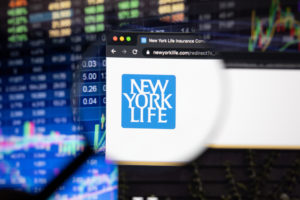
MLOps Pays Dividends for New York Life

Machine learning has the potential to generate millions of dollars in savings and revenue growth for organizations. Nobody in the data business doubts that anymore. But unless ML models are actually put into production, it’s just a bunch of useless code. This is the big data science takeaway from New York Life, which recently adopted an MLOps solution from Domino Data Lab to streamline model deployment.
Since it was founded in 1845, statistics have played a central role for New York Life. Like all life insurance companies, New York Life dedicates resources to maintaining accurate actuarial tables, which play a big role in determining premiums, payouts, and profits. As the country’s largest mutual life insurance company, with over $700 billion in assets, New York Life clearly has succeeded in that department.
But about five years ago, the company set out to find new ways to use data and statistics to help its business. It created a centralized data science organization, New York Life’s Center for Data Science and Artificial Intelligence, that would infuse analytics and machine learning technologies into teams across the company.
“We interact with all the major business areas,” says Glenn Hofmann, New York Life’s chief analytics officer, who heads the data science team. “Our internal business partners include the distribution organization, marketing, underwriting, and many others. We work across the enterprise to build data science and AI models and deploy them.”
The MLOps Gap
Hofmann’s team consists of 30 to 40 data scientists, who work mostly in the Python and R stack and develop primarily in Jupyter data science notebooks and RStudio tools. In addition to project managers, a change manager, model governance and a training and development team, the supporting cast includes 10 individuals who work in machine learning operations (MLOps), as well as another 20 to 30 people on the technical team who maintain the infrastructure on prem and in the cloud, he says.
For the first few years after forming the data science group, the team struggled a bit with ML model deployment. The ML models that its data scientists wrote in Python and R would often need to be rewritten into another language, and then tested. That slowed down deployment of ML models, Hofmann says.
“It was definitely a much more complex process,” he tells Datanami. “A lot of times, we had to translate code…to Java or C. The translation doesn’t take so long, but the QA [quality assurance] on that can take three months to get it right.”
The technical and operational gap between the data science and infrastructure teams meant that a lot of time and energy were spent standardizing the output from the data science teams. This meant that a ML model that was deployed for one use case could not be reused for another.
“We have an architecture team and we have a security team,” Hofmann says. “You can’t just deploy anything. It has to fit into the corporate architecture.”
The company sought a way to streamline that process and close the gap between data science and IT. That would not only result in a faster turnaround for ML models, but would also make for happier data scientists.
New ML Life
About a year and a half ago, New York Life addressed the MLOps gap by implementing a model management solution from Domino Data Lab.
The San Francisco company develops software that functions as a “system of record” for ML models and the teams who create them. It lets data scientists develop models using their choice of tools and languages, and serves as a repository for reusing code and artifacts from ML experiments.
But when it’s time to deploy the models into production, the platform takes control and brings automation to the process. It does this by packaging up the ML models and deploying them–in New York Life’s case, they’re deployed in the AWS cloud atop Kubernetes.
According to Hofmann, the Domino Enterprise MLOps Platform has helped New York Life bring more efficiency to its data science operations.
“It’s very critical because every model we deploy now is deployed on Domino,” he says. “It has sped up the process and it has made us more efficient. It also enables us to do better governance because all the models are in one place, so it’s easier to govern than before. It’s an integral part in the process.”
New York Life’s data scientists still do most of their work in Jupyter or RStudio. But the handoff between the data science team and the infrastructure team is much quicker and smoother as a result of the Domino platform and the automation that it brings, Hofmann says.
The company’s machine learning operations engineers still work with data scientists to analyze the data and the models that the data science team wants to use. That part has not changed. But the way these two teams interact is much better with Domino, the chief analytics officer says.
“They [the MLOps engineers] already look at the code and say ‘OK, are you using any data sources that are difficult to deploy? Are you using any particular code features that are hard to deploy?’ This way they’re already getting in the middle of it and help them write better code and make sure everything is deployable,” Hofmann says.
“And then by the time the model is finalized, the MLOps engineers take over and get the model ready for production,” he continues. “It’s a collaboration between the MLOps and technology teams to deploy a model, make sure it’s good, do all the QA, do all the testing. And then, once it’s deployed, it gets managed by the technology organization, and we focus on the next one.”
Happy Data Scientist, Happy Life
The greater efficiency brought by the Domino platform enables New York Life to scale up its deployment of ML models. According to Hofmann, the company is deploying about a dozen models per year now, which is up significantly from prior years, and that number promises to grow in the future.
Having a modern data science and MLOps environment is not only good for the various departments that Hofmann’s team supports with machine learning models. It’s also good for the data science team itself, he says.
“We have the tools that data scientists expect to use. We’ve got a lot of interesting data to explore and new data coming in all the time. The business opportunities are both challenging and exciting,” Hofmann says. “And all of the solutions get deployed. For data scientists, it is important that their work actually gets deployed into the business and creates benefits. That’s the case at New York Life.”
It’s not all about supporting the self-esteem of data scientists, although that is important. In the cutthroat market for the services of data scientists, no advantage is too small.
“The fact that we have modern infrastructure, the fact that all of the work gets deployed into the business, the fact that we have good training programs – all that seems to resonate with data scientists who are looking for a compelling career opportunity,” says Hofmann.
Related Items:
Data Science Needs to Grow Up, Domino Says
Growing Focus on MLOps as AI Projects Stall
Data Science Success All About the Models, Domino Says





























